|

Winter
1998 (6.4)
Pages 66-68

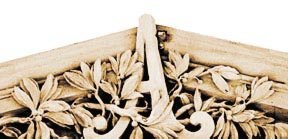 The
ABC's of Baku
The
ABC's of Baku
Monograms
on the Oil Baron Buildings
by Anne Kressler
Hundreds
of beautiful mansions were built in Baku during the Oil Boom
period (1885 to 1915). At that time, Baku was producing more
than 50 percent of the world's supply of oil, even more than
America. With the money Azerbaijanis made from selling the oil,
many beautiful private mansions were built. Some were as big
as a city block and had 50 to 60 rooms. The Oil Barons wanted
people to remember them even after they died, so it became a
tradition to use the initials of their names and make very decorative
designs called monograms.
Sometimes the owner used only one letter-such as "M"
for Mukhtarov (pronounced mukh-TAH-rov). Others chose two letters-such
as "MN" for Musa Naghiyev (pronounced NAGH-ee-yev).
Sometimes they used three letters- such as "TAA" for
Teymur Ali Ashurbeyov (pronounced a-shur-BEH-yov). Traditionally,
a person's middle name was the same name of his or her father.
This was, and still is the custom, even for girls. For example,
the oldest daughter of Teymur Ashurbeyov was named Sara Teymur
Ashurbeyov.
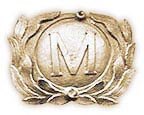
Mukhtarov |
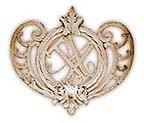
Ashurbeyov |
During the Oil
Boom, the Azerbaijani language was officially written in the
Arabic script. However, Cyrillic letters used for the Russian
language were more prestigious and that's why most of the building
monograms use Cyrillic even though Cyrillic did not become the
official alphabet until 1938.
You'll discover that some letters in the Cyrillic alphabet look
just like English letters; others are very different. For example
the letter "N" in Cyrillic looks like the English letter
"H". Musa Naghiyev's initials look like "MN"
in English but "MH" in Cyrillic.

Naghiyev |

Taghiyev
|
When the Russian
Bolshevik army came to Baku in 1920 to set up a new government
based on communism (1920-1991), they told the poor people that
wealth should be shared by everyone, not just rich people.
So the Bolsheviks killed many owners of these beautiful buildings
and stole their homes and everything inside. Some of the families
escaped before the soldiers came. Then the Bolsheviks ordered
many families to come live in these big homes. So instead of
one family, sometimes 20 families lived together in these big
mansions. Of course, there weren't enough kitchens and bathrooms
so the families had to share them.
Here is the story of some of the owners of these buildings and
what happened to them when the Bolsheviks came. You can see pictures
of most of the mansions in the Oil Baron article (pages 29-40)
under the name of the owner.
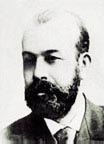 |
A is for Asadullayev
Asadullayev
(1840-1913) (pronounced ah-sah-du-LAH-yev) was famous as the
"Oil and Kerosene King." He was born into a poor family
but came to own 40 oil derricks that produced nearly 6 million
barrels of oil per year. He died before the Bolsheviks came and
his home was divided up into many apartments. His family had
to flee the country and today one of his granddaughters, Zulekha
Khanim, lives in Washington, D.C. |
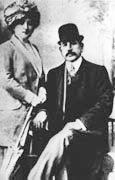 |
M is for Mukhtarov
Murkhtarov
(pronounced mukh-TAH-rov) was an oil engineer and an Oil Baron.
He and his wife Liza traveled to Europe where his wife saw a
beautiful palace. He decided to build one like it in Baku. Mukhtarov
hated the Bolsheviks so much that he said that he would never
let them enter his house. But when they came riding up the palace
stairs on their horses, he got his gun and shot at them. Then
he shot and killed himself. Lisa Khanim had to live in one room
in the basement of her palace. Finally she escaped to Turkey.
The mansion is now the Wedding Palace where young couples come
to get married (See Mukhtarov, page 39-40). |
 |
MN is for
Musa Naghiyev
(1849-1919)
Naghiyev (pronounced NAGH-ee-yev) was considered the wealthiest
Oil Baron. He is remembered for building a hospital and a palace.
Unfortunately, his son Ismayil (pronounced is-mah-YIL)
became very ill with tuberculosis. Even huge amounts of money
couldn't cure him, and he died. His father decided to build a
palace in memory of his son. He called it Ismayilla. In 1918
Bolsheviks and Armenians burnt down the beautiful palace. Naghiyev
died the following year before the palace could be rebuilt (See
Academy
of Science,
page 30).
In the Russian
alphabet (Cyrillic) the letter for "N" looks like "H".
|
 |
TAA stands
for Teymur Ali Ashurbeyov
(pronounced
a-shur-BEH-yov). Ashurbeyov died in 1904 just as the mansion
was being finished as a wedding present for his son Bala bey.
When the Bolsheviks came, Bala bey took his wife and six children
to Turkey where they lived for six years by selling diamonds
that they had brought with them when they fled the country. But
Bala bey was very homesick. Six years later, thinking that it
would be safe for them, he took his family back to Baku. It was
a tragic mistake. He was arrested just because he had been an
"Oil Baron" and sentenced to death in 1937 (See Ashurbeyov,
page 32).
This is a photo
of Teymur's grandchildren who grew up in the mansion. The oldest
one is Sara. In 1999, she was still living and was 93 years old.
|
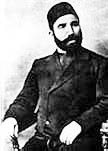 |
ZT is for
Zeynal-abdin Taghiyev
(1823-1924)
Taghiyev (pronounced zey-NAL-a-ba-din TAGH-i-yev) who was an
Oil Baron and a philanthropist, meaning that he gave away much
of his money to help others. As a child, Taghiyev was very poor
and could not go to school so he grew up barely knowing how to
read and write. Taghiyev built the first school for girls in
Baku. Until then, only boys could go to school.
The people remembered
Taghiyev's kindness and respected
him. This made the Soviet leaders angry. If you look closely
at the monogram on his house, you'll see that they tried to chisel
away the "ZT" and leave Taghiyev's monogram blank so
that people would forget who built this beautiful mansion. But
the plan didn't work; people still remember him and love him
even one hundred years later (See Taghiyev, page 39).
|
Fuad Akhundov
also contributed to this article.
From Azerbaijan International (6.4) Winter 1998.
© Azerbaijan International 1998. All rights reserved.
Back to Index
AI 6.4 (Winter 1998)
AI Home
| Magazine
Choice | Topics
| Store
| Contact
us
|











